Georgia's therapists worked with her teachers
 |
 |
Tony and Kim’s daughter Georgia had a stroke when she was 11 months old. Georgia had an aneurysm – a weak spot on an artery wall in her brain. The aneurysm burst, causing a haemorrhagic stroke.
The family had just moved to Sydney from interstate, and they didn’t have much in the way of family support. “We were lucky that our friends supported us, and Kim’s mum flew in from interstate to look after us, bringing in food and doing the washing,” says Tony.
Despite everything that was happening, Tony and Kim kept level heads. “We tried to keep calm when working with the treating team, so they could focus on Georgia,” Tony says.
Tony and Kim had to be assertive when Georgia needed blood drawn for tests. “She’s got very fine blood vessels, so taking blood could be difficult. We were quite firm about asking for someone experienced. Otherwise it caused so much distress for Georgia” says Kim.
The lesson for the couple was that they had to watch out for Georgia’s best interests.
“It’s important not to let someone else take ownership and control,” Tony says.
Tony and Kim were focused on getting Georgia into rehabilitation therapy as soon as possible. “Georgia started speech therapy, occupational therapy and physiotherapy in hospital. Georgia was listed as urgently needing therapy once discharged. So, within eight weeks of us leaving hospital, she was in speech therapy, occupational therapy, physiotherapy and hydrotherapy” Tony says.
“We knew about neuroplasticity of the brain. She was young enough that if you really get onto it as soon as possible, you can do amazing things,” Kim says. “You need to work with your team to identify supports available through the hospital and in the community.”
They also emphasise the importance of understanding how your child works best with their therapy team, structuring the journey around your child.
“For us, we found that Georgia responded extremely well to intense therapy. So we did a six-week intensive, which was a lot of work for us as a family, going four days a week for six weeks. But we saw dramatic changes come from that,” Tony says.
Kim also stresses that finding the right therapists is key.
“You need to ask if they’ve worked with children with brain injuries. The problem we found was getting on their list – but it’s worth waiting for people who are experienced” says Kim.
Tony adds that if you feel like the relationship between your child and their therapist isn’t working, don’t be afraid to go elsewhere. "You’ve got to find therapists who are going to work well with you as a family to give your child the best outcomes,” he says.
A big challenge for the family was Georgia starting school. Again, working with their team and being advocates for Georgia were important.
“Georgia had a neuropsychology assessment to identify her areas of need. The report gave advice to the teachers on how best approach learning with her. It was very clear about what she needed, even down to where she should sit in the classroom so she’s not easily distracted. Her therapists then went to her school to work with the teachers.”
Tony and Kim both say that looking into what's available for your child is important. “For example, children who have had a stroke can be afraid of getting involved in sports due to reduced confidence, weakness and coordination. It’s important to look at it from the perspective of how they can be supported so they can participate and get the rewards,” says Tony.
When asked for advice for other parents, Tony says “don't be afraid to ask questions and push for what’s best for your child. If you feel that your child needs additional support, ask for it and keep pushing, especially with the National Disability Insurance Scheme. Ensure what you need is in your plan,” Tony says.
“You’ve got a window of opportunity to help your child be as good as they can be, so you need to do as much as you can in that time” says Kim. “Don’t settle. Look for what works best for your child and family.”
